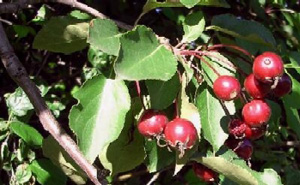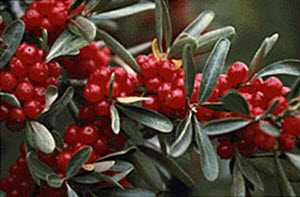
The Shand Greenhouse has grown and distributed over 12.5 million seedlings to date.
Various groups, environmental agencies and our customers plant our seedlings each year. The seedlings are mainly used to:
- Help our rural customers to establish shelterbelts on their own properties
- Help create habitat for wildlife in conservation projects
To grow seedlings year-round, we use waste heat from the adjoining Shand Power Station as a primary heating source for the Shand Greenhouse. The greenhouse grows around 500,000 tree and shrub seedlings annually. As these trees and shrubs grow, they help absorb CO2 from the atmosphere.
Apply for Free Seedlings
![]()
The application window for Spring 2026 seedlings will open on Aug. 1, 2025.
Plant Trees Safely
Trees that are near or touching power lines are dangerous. Nearly 1,000 power outages a year are caused by trees touching power lines. Learn more about trees and power line safety.
Our Seedlings
We have a variety of seedlings to meet your needs:
|
Colorado Blue Spruce
|
This hardy evergreen can grow up to 30 metres in height and is known for its striking bluish colour. This tree is slow growing, but can live for several hundred years. Colorado Blue Spruce is fairly wind tolerant and grows in acidic soils. It dislikes shade and is intolerant of air pollutants. Every 2 to 3 years this tree will produce a crop of long, soft cones. |
|
Jack Pine  |
This tree can grow up to 20 metres tall. It has a conical crown and open, ascending branches. If found in a forest stand, it is slender with a short crown and sparse branching. The needles are in bundles of 2 and the bark matures into dark brown irregular plates. The hard cones are 3 to 7 centimetres and sealed by a resin bond. They can be opened by the heat from a fire or exposure to sunlight. |
|
Scot’s Pine  |
This coniferous tree grows 15 to 18 meters. It has needles grouped in pairs, twisted and blue-green in colouring. Cones are green to light brown. smooth. curved and cling closely to stems. It is conspicuous because of its orangish-red. peeling bark. As the tree matures, the crown tends to have a more open, broad form. |
|
Siberian Larch  |
Siberian Larch is a conifer (cone bearing) tree, but not evergreen, as it loses its needles in the fall. It is pyramidal in shape and will grow up to 15 metres (50 feet). It is relatively fast growing when compared to other conifers, and can grow up to 0.5 metres per year. Its branches arch upward at the tip. It has a relatively non-competitive root system. |
|
White Spruce  |
Tall coniferous (evergreen) tree growing from 7 to 20 metres (21 to 60 feet) tall. The bark is brown and scaly. The branches tend to droop slightly. Needles are blue-green in colour but often display a whitish bloom. When crushed the needles emit a distinct "skunky" odour. The soft cones can be up to 5.5 centimetres long and the needles are square in cross-section. |
|
Acute Willow
|
A medium to large multi-stemmed tree that is often as wide as it is tall. Trees are either male or female (dioecious) and produce their catkins before the leaves bud out early in the spring; male catkins are silvery with gold anthers while the female catkins are half the size and green. This species is valuable for wildlife habitat. |
|
Green Ash
|
Green ash can grow to 12 metres. Its compound leaves have 5 to 7 oval, tapered leaflets that are some of the last to emerge in the spring, but some of the first to drop in the autumn. The leaves become bright yellow in fall. The bark is greyish-brown, becoming narrowly furrowed with age. The seed is single-winged, which hangs in clusters and can remain on the tree late into the winter. Male and female flowers are located on separate trees (dioecious). |
|
Hybrid Poplar
|
This tree is a native and European type that grows at a very fast rate and up to 25 metres tall. The broad, glossy and heart shaped leaves stem from reddish brown twigs. |
|
Manitoba Maple
|
This tree can reach a height of 12 metres. Its trunk is often divided near the ground and is generally light grey and smooth, darkening and furrowing with age. The compound leaves have 3 to 5 leaflets that can be lobed. The distinguishing feature of this tree is its "helicopter seeds". They are double-winged samaras that resemble helicopters as they spin to the ground. Male and female flowers are found on separate trees (dioecious). |
|
Paper Birch
|
A large tree growing to 15 metres (50 feet). It has distinctive white bark that tends to peel into sheets. In spring it bears a catkin (cone-like flower) which produces tiny, papery, winged seeds. |
|
Plains Cottonwood
|
The Plains Cottonwood is a large, fast growing tree with a large trunk, deeply furrowed bark and branching crown. It can grow up to 30 metres high and typically lives around 50 rears. Specimens in North Dakota are known to be over 50 years old. The shiny, toothed leaves are heart-shaped and the seeds are born on female trees in clusters of pods. These split to release large quantities of white cotton and tiny white-ish seeds. |
|
Siberian Crab Apple
|
This tree has a full, rounded canopy and remains quite small, growing 7-17 m tall. In the spring, fragrant pink blooms, fading to white appear throughout the canopy. In the fall, the tree is covered with hard, bright red ro yellow fruits that are about the size of small cherries. |
|
Trembling Aspen
|
A large tree growing to 20 to 30 metres. It is conspicuous because of its "noisy leaf" from which it derives its name. Its ovate leaves, which come to an abrupt point at the tip, appear to "quake" in the wind. The tree has greyish-white bark that darkens and becomes furrowed with age. Reproduction is mainly through root suckers. That means aspens produce a cottony seed that is released from pod-like structures. Aspen have both male and female trees (dioecious). |
|
Buffaloberry
|
A large shrub growing to 4 metres (15 feet) in height. Branches tend to grow at right angles to the stem with spines present at the tip. Leaves are a silvery colour and round in shape. Small, yellowish flowers appear in May to June. Plants are either male or female, so both sexes must be present for fruit to occur. Bright red clusters of berries appear on the stems of the female plants in mid summer. |
|
Caragana
|
Caragana is a multi-stemmed shrub with an upright and spreading canopy that may become leggy as it ages if not rejuvenated periodically. Caragana is in the legume family and fixes nitrogen which allows it to grow well in nutrient poor soils and increases its competitive ability. |
|
Chokecherry
|
A small tree growing between 2 and 4 metres. Creamy, white flower clusters appear in early summer followed by a stringent red-black fruit. Leaves are dark green, sharply toothed, and are arranged alternately on the stem. The plane has distinctive grey bark with noticeable horizontal white markings. |
|
Pincherry
|
A small tree growing up to 5 metres. It bears small, round clusters of white flowers in May-June as the leaves begin to appear. Flowers are followed by small, red cherry-like fruit in mid-summer. The bark of young wood is a shiny, reddish-brown color. Leaves are bright green, lanceolate and finely toothed. |
|
Red Elder
|
This fast growing shrub can grow up to 4 metres high and l to 2 metres wide. It is characterized by light green leaves that occur on the stems in odd numbers. They have a distinctive smell that is reminiscent of iron or rust. The leaves are toothed or can be deeply lobed. It produces small white flowers followed by clusters of red berries which are a favourite food of birds. |
|
Red-Osier Dogwood
|
This shrub, previously known as Cornus stolonifera. It grows 1 to 2 metres (3 to 6 feet) with conspicuous reddish bark. Leaves are ovate, opposite and have smooth edges. White flowers are borne on flat-topped clusters in early June followed by bluish-white berries later in summer. |
|
Saskatoon
|
Saskatoon is a large shrub, growing from I to 4 metres. It has a simple rounded leaf with prominent veining. New leaves will have downy white hair. Among the first shrubs to bloom in early May, it produces small, white flowers that become sweet, purple berries. The stems and branches are dark brown in color. It is also known as juneberry and serviceberry in other parts of the country or continent. |
|
Sea Buckthorn
|
This silver shrub grows about 3 to 4 metres tall and wide. It has long, thin leaves and large bright yellow-orange berries that form in clusters close to the primary branches. The smooth, grey bark gives rise to 4 to 5 centimetres long sharp thorns. |
|
Shrub Willow
|
This shrub has a full, rounded canopy and remains quite small, growing 2 to 3 metres tall. Depending on the species, they may remain in a more individual, globe shaped structure or they may spread into thickets. In the spring, pollen catkins and seed catkins form on separate shrubs. Seed forms in small capsules in the catkin that pop open to release the seed on silky fluff via wind dispersal. |
|
Villosa Lilac
|
This shrub grows 3 to 5 metres tall and spreads about 2.5 metres. le is rapid growing and can live over 50 years. The leaves are chick and dark green with smooth edges. The flowers appear in mid to late June and range from purple to white. The flowers produce distinctive scent and form flat, woody seed capsules. This shrub is drought and sun tolerant and doesn't sucker. |
|
Western Sandcherry
|
A fast growing open form shrub with narrow, smooth, silvery-green leaves. Clusters of white flowers develop in late May to early June. Flowers are "perfect" having both male and female flower parts pollinated by insects. Dark purple edible berries form in late July to early August. Height may reach 0.5 to 2 metres. Bark is reddish brown developing a silver hue with age. Prefers partial shade to full sun. |





















